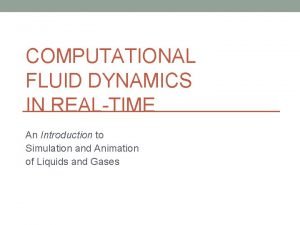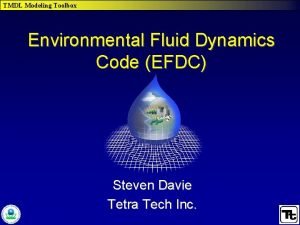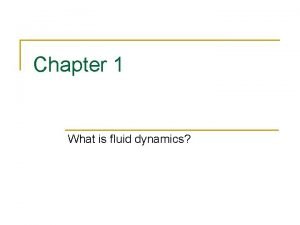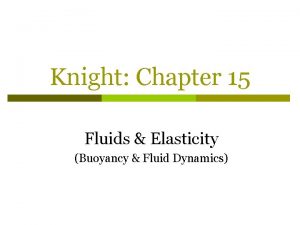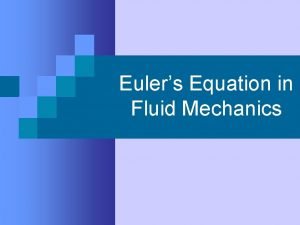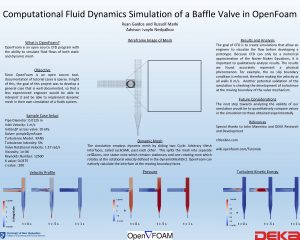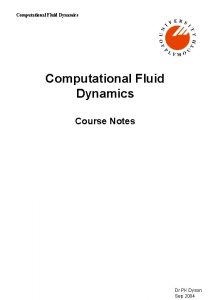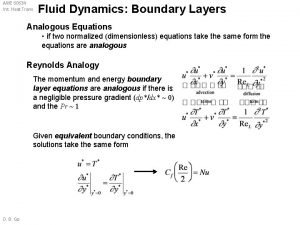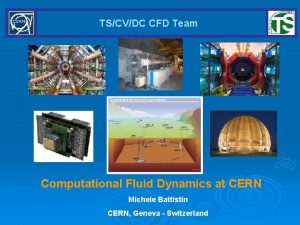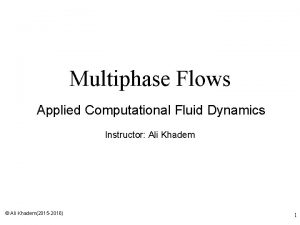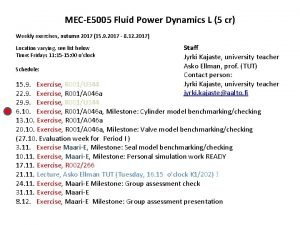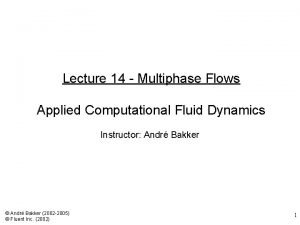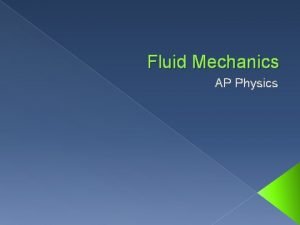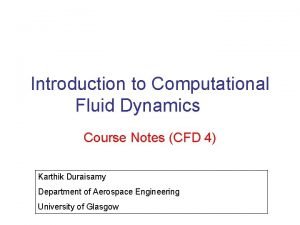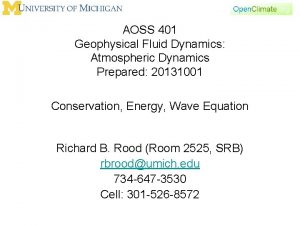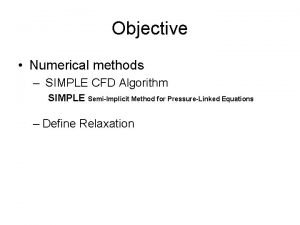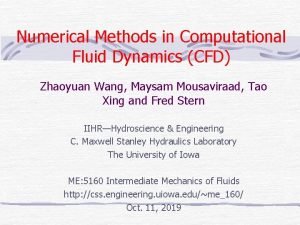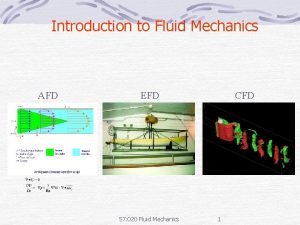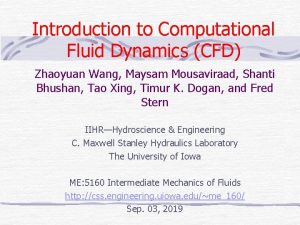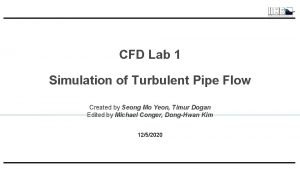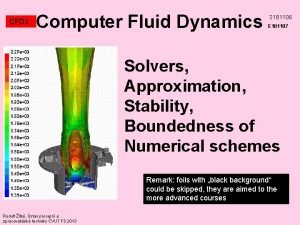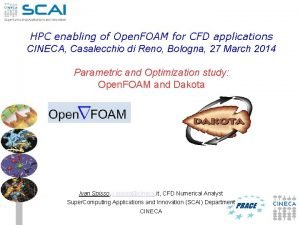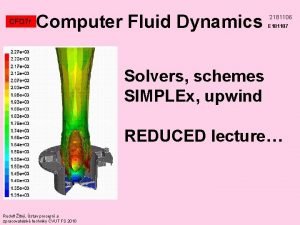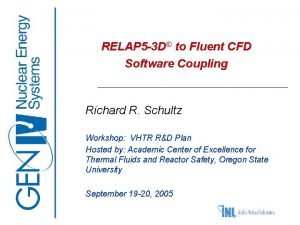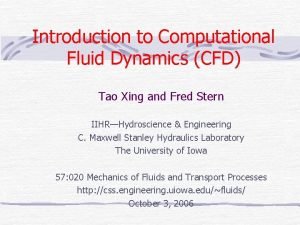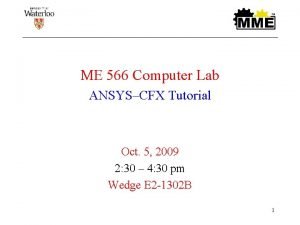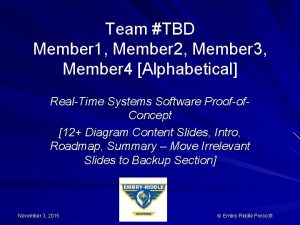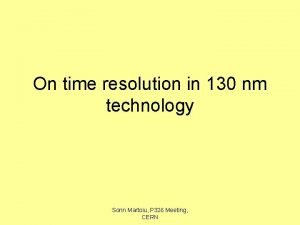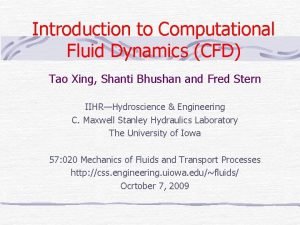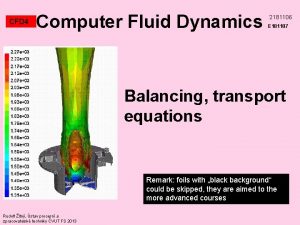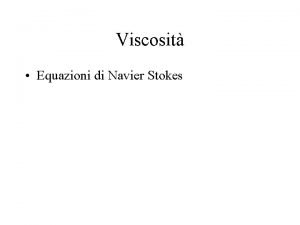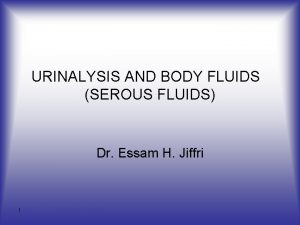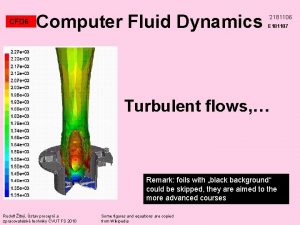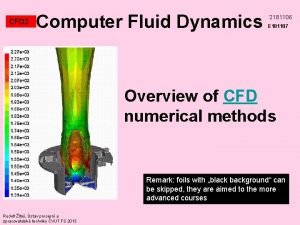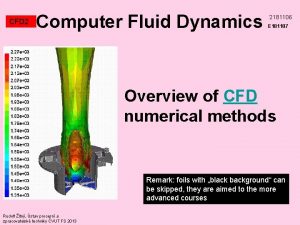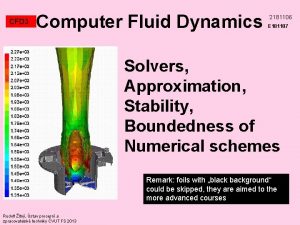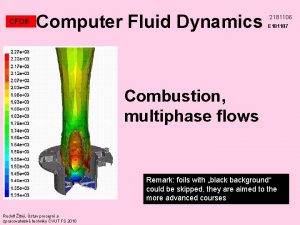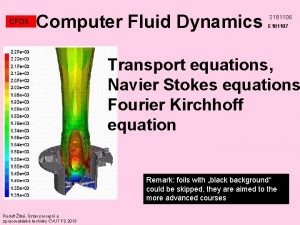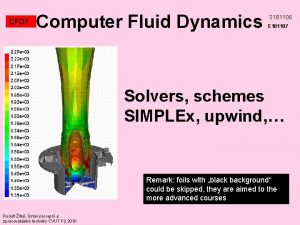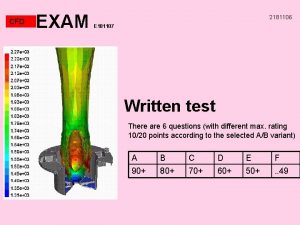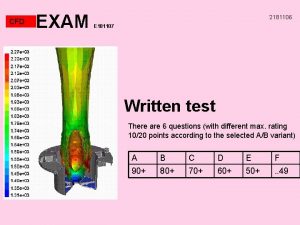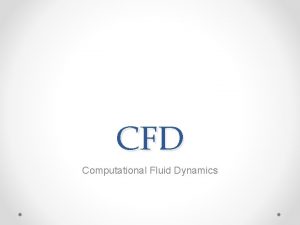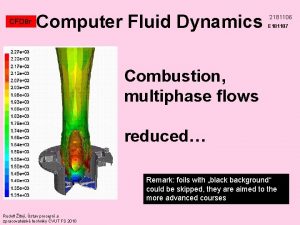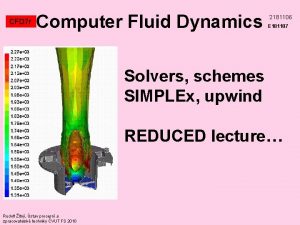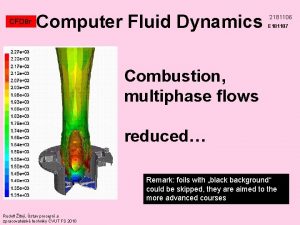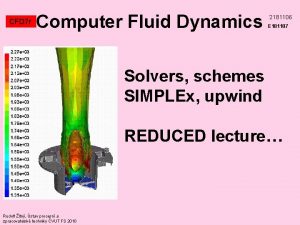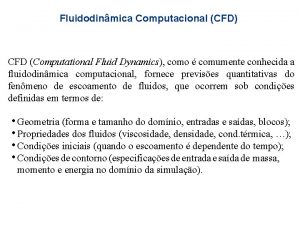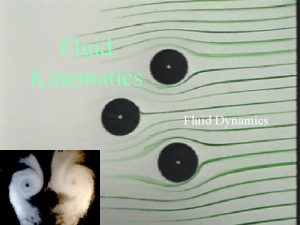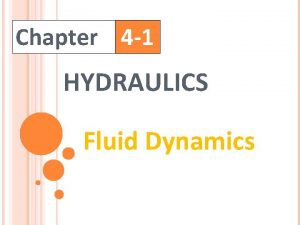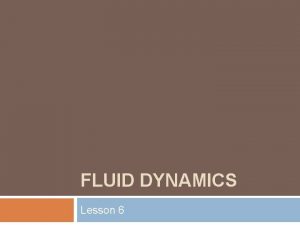CFD 2 Computer Fluid Dynamics 2181106 E 181107























































- Slides: 55

CFD 2 Computer Fluid Dynamics 2181106 E 181107 Overview of CFD numerical methods Remark: foils with „black background“ can be skipped, they are aimed to the more advanced courses Rudolf Žitný, Ústav procesní a zpracovatelské techniky ČVUT FS 2013

CFD 2 CFD and PDE CFD problems are described by transport partial differential equations (PDE) of the second order (with second order derivatives). These equations describe transport of mass, species, momentum, or thermal energy. Result are temperature, velocities, concentrations etc. as a function of x, y, z and time t PDE of second order are classified according to signs of coefficients at highest derivatives of dependent variable (for more details, see next slides): ØHyperbolic equations (evolution, typical for description of waves, finite speed of information transfer) Examples: supersonic flow around a plane, flow in a Laval nozzle, pulsation of gases at exhaust or intake pipes convection by velocity c ØParabolic equations (evolution problems, information is only in the direction of evolution variable t usually time but it could be also distance from the beginning of an evolving boundary layer) Examples: evolution of boundary layer (in this case trepresents spatial coordinate in the direction of flow and x is coordinate perpendicular to the surface of body) ØEliptic equations (typical for stationary problems, infinite speed of information transfer) Examples: subsonic flows around bodies (spheres, cylinders), flow of incompressible liquids

CFD 2 CFD and PDE Why is it important to distinguish types of PDE? Because different methods are suitable for different types (e. g. central differencing in elliptical region and time marching schemes in hyperbolic or parabolic regions)

CFD 2 Characteristics (1/3) f can be function of x, y, and first derivatives. y x( ), y( )-parametrically defined curve, where first derivatives p( ), q( ) are specified x

CFD 2 Characteristics (2/3) Right hand side is fully determined by prescribed first derivatives (by boundary conditions) along selected curve Proof!!!

CFD 2 Characteristics (3/3) Is the solution of quadratic equation correct? Check signs.

CFD 2 Characteristics Wave equation - hyperbolic t Value at point x, t is determined only by conditions at red boundary There can be discontinuity across the characteristic lines) Domain of dependence x

CFD 2 PDE type - example One and the same equation can be in some region elliptic, in other hyperbolic (for example regions of subsonic and supersonic flow, separated by a shock wave). y x An example is Prandl-Glauert equation describing steady, inviscid, compressible and isentropic (adiabatic) flow of ideal fluid around a slender body (e. g. airfoil) Function (x, y) is velocity potential, M is Mach number (ratio of velocity of fluid and speed of sound). For M<0 (subsonic flow region) the equation is elliptic, for M>1 (supersonic flow) the equation is hyperbolic. See wikipedia. Another example: Laval nozzle

CFD 2 PDE type – example PWV Pulse Wave Velocity in elastic pipe (latex tube, arteries) Model-hyperbolic equations Experiment-cross correlation technique using high speed cameras Macková, H. - Chlup, H. - Žitný, R. : Numerical model for verification of constitutive laws of blood vessel wall. Journal of Biomechanical Science and Engineering. 2007, vol. 2, no. 2/1, p. s 66.

CFD 2 PDE type – example WH Water Hammer experiment with elastic pipe (latex tube, artificial artery) Model-hyperbolic equations Experiment-cross correlation technique using high speed cameras Pressure sensors

CFD 2 Hyperbolic equations WH Flows in a pipe. Time dependent cross section A(t, x), or time dependent mean velocity v(t, x). Compressible fluid or elastic pipe. Relationship between volume and pressure is characterised by modulus of elasticity K [Pa] related to speed of sound a Problem is to predict pressure and flowrate courses along the pipeline p(t, x), v(t, x). Basic equations: continuity and momentum balance (Bernoulli). In simplified form neglected convective term. f-is friction factor Velocity v(t, x) can be eliminated by neglecting friction, giving Speed of sound

CFD 2 Hyperbolic equations WH How to derive equations of characteristics multiply by and add both equations

CFD 2 Hyperbolic equations WH There are two characteristic lines corresponding to two values of C x 1=at A Integration along the characteristic line from A to C x 2=-at Integration along the characteristic line from B to C B

CFD 2 Method of characteristic Solution of previous system of 2 algebraic equations C x 1=at A p=p 0 C v(t) B A h x 2=-at B h/a

CFD 2 Method of characteristic Pipe L=1 m, D=0. 01 m, speed of sound a=1 m/s, inlet pressure 2 k. Pa (steady velocity v=0. 6325 m/s). l=1; d=0. 01; rho=1000; f=0. 1; a=1; p 0=2 e 3; v 0=(p 0*2*d/(l*rho*f))^0. 5 n=101; h=l/(n-1); v(1: n)=v 0; p(1)=p 0; for i=2: n p(i)=p(i-1)-f*rho*v 0^2*h/(2*d); end dt=h/a; tmax=3; itmax=tmax/dt; fhr=f*h/(2*a*d); for it=1: itmax t=it*dt; for i=2: n-1 pa=p(i-1); pb=p(i+1); va=v(i-1); vb=v(i+1); pc(i)=a/2*((pa+pb)/a+rho*(va-vb)+fhr*(vb*abs(vb)-va*abs(va))); vc(i)=0. 5*((pa-pb)/(rho*a)+va+vb-fhr*(vb*abs(vb)+va*abs(va))); end pc(1)=p 0; vb=v(2); pb=p(2); vc(1)=vb+(pc(1)-pb)/(a*rho)-fhr*vb*abs(vb); vc(n)=v 0*valve(t); va=v(n-1); pa=p(n-1); pc(n)=pa-rho*a*(vc(n)-va)+f*h*rho/(2*d)*va*abs(va); time (0 -3 s) vres(it, 1: n)=vc(1: n); pres(it, 1: n)=pc(1: n); p=pc; v=vc; end pmax=max(pres))/p 0 x=linspace(0, 1, n); time=linspace(0, tmax, itmax); contourf(x, time, pres, 30) Pressure profiles n=301 n=101

CFD 2 Method of characteristic Incorrect boundary condition at exit (elastic and rigid tube connection) D C Le A Bernoulli at an elastic tube Bernoulli at a rigid tube e

CFD 2 Method of characteristic Classical numerical methods (Lax Wendroff), require at least slightly flexible connected pipe. MOC seems to be working with a rigid pipe too? function vrel=pump(t) vrel=0. 5*sin(3*t); n=401, Le=0. 1, pmax=669 n=401, Le=0, pmax=669 n=401, Le=1, pmax=709 n=401, Le=0. 5, pmax=669 n=401, Le=2, pmax=803

CFD 2 NUMERICAL METHODS The following slides are an attempt to overview frequently used numerical methods in CFD. It seems to me, that all these methods can be classified as specific cases of Weighted Residual Methods. Schiele

CFD 2 MWR methods of weighted residuals Principles of Weighted Residual Methods will be demonstrated for a typical transport equation (steady state) – transport of matter, momentum or energy Convective transport Dispersion (diffusion) Inner sources Numerical solution (x, y, z) is only an approximation and the previous equation will not be satisfied exactly, therefore the right hand side will be different from zero res(x, y, z) is a RESIDUAL of differential equation. A good approximation should exhibit the smallest residuals as possible, or zero weighted residuals wi are selected weighting functions, and V is the whole analyzed region.

CFD 2 Approximation – base Approximation is selected as linear combination of BASE functions Nj(x, y, z) Substituting into weighted residuals we obtain system of algebraic equations for coefficients I (N-equations for N-selected weight functions wi)

CFD 2 Weighting functions can be suggested more or less arbitrarily in advance and independently of calculated solution. However there is always a systematic classification and families of weighting functions. Majority of numerical methods can be considered as MWR corresponding to different classes of weighting functions ØSpectral methods (analytical wi(x)) (Boundary element methods) ØFinite element methods (Galerkin – continuous weighting function) xi ØControl volume methods (discontinuous but finite weighting function) (or Finite Volume methods) xi ØCollocation methods (zero residuals at nodal points, infinite delta functions) (Finite Differences) xi

CFD 2 SPECTRAL METHOD ORTHOGONAL FUNCTIONS General characteristics ØAnalytical approximation (analytical base functions) ØVery effective and fast (when using Fast Fourier Transform) ØNot very suitable for complex geometries (best case are rectangular regions)

CFD 2 SPECTRAL METHOD ORTHOGONAL POLYNOMIALS Weight functions and base functions are selected as ORTHOGONAL functions (for example orthogonal polynomials) Pj(x). Orthogonality in the interval x (a, b) means In words: scalar product of different orthogonal functions is always zero.

CFD 2 WHY ORTHOGONAL? Why not to use the simplest polynomials 1, x, x 2, x 3, …? Anyway, orthogonal polynomials are nothing else than a linear combination of these terms? The reason is that for example the polynomials x 8 and x 9 look similar and are almost linearly dependent (it is difficult to see the difference by eyes if x 8 and x 9 are properly normalised). Weight functions and base functions should be as different (linearly independent) as possible. See different shapes of orthogonal polynomial on the next slide. Remark: May be you know, that linear polynomial regression fails for polynomials of degree 7 and higher. The reason are round-off errors and impossibility to resolve coefficients at higher order polynomial terms (using arithmetic with finite number of digits). You can perform linear regression with orthogonal polynomials of any degree without any problem. There is other reason. Given a function T(x) it is quite easy to calculate coefficients of linear combination without necessity to solve a system of algebraic equations: Proof!!!

CFD 2 Orthogonal polynomials HERMITE polynomial TSCHEBYSHEF I. polynomial

CFD 2 SPECTRAL METHOD FOURIER EXPANSION Goniometric functions (sin, cos) are orthogonal in interval (- , ). Orthogonality of. Pn(x)=cos nx follows from for m=n, otherwise 0 Proof!!! In a similar way the orthogonality of sin nx can be derived. From the Euler’s formula follows orthogonality of i-imaginary unit Linear combination of Pj(x) is called Fourier’s expansion The transformation T(x) to Tj for j=0, 1, 2, …, is called Fourier transform and its discrete form is DFT T(x 1), T(x 2), …. T(x. N) to T 1, T 2, …TN. DFT can be realized by FFT (Fast Fourier Transform) very effectively.

CFD 2 SPECTRAL METHOD EXAMPLE Poisson’s equation (elliptic). This equation describes for example temperature in solids with heat sources, Electric field, Velocity potential (inviscid flows). Fourier expansion of two variables x, y (i-imaginary unit, not an index) Substituting into PDE Evaluated Fourier coefficients of solution Technical realization ØUse FFT routine for calculation fjk ØEvaluate Tjk ØT(x, y) by inverse FFT

CFD 2 FINITE ELEMENT method General characteristics ØContinuous (but not smooth) base as well as weighting functions ØSuitable for complicated geometries and structural problems ØCombination of fluid and structures (solid-fluid interaction)

CFD 2 FINITE ELEMENT method Base functions Ni(x), Ni(x, y) or Ni(x, y, z) and corresponding weight functions are defined in each finite element (section, triangle, cube) separately as a polynomial (linear, quadratic, …). Continuity of base functions is assured by connectivity at nodes. Nodes xj are usually at perimeter of elements and are shared by neighbours. Base function Ni (identical with weight function wi) is associated with node xi and must fulfill the requirement: (base function is 1 in associated node, and 0 at all other nodes) In CFD (2 D flow) velocities are approximated by quadratic polynomial (6 coefficients, therefore 6 nodes ) and pressures by linear polynomial (3 coefficients and nodes ). Blue nodes are prescribed at boundary. Verify number of coeffs. ! y 3 6 5 1 4 2 x

CFD 2 FINITE ELEMENT example Poisson’s equation MWR and application of Green’s theorem Derive Green’s theorem! Base functions are identical with weight function (Galerkin’s method) wi(x)=Ni(x) Resulting system of linear algebraic equations for Ti

CFD 2 BOUNDARY element method General characteristics ØAnalytical (therefore continuous) weighting functions. Method evolved from method of singular integrals (BEM makes use analytical weight functions with singularities, so called fundamental solutions). ØSuitable for complicated geometries (potential flow around cars, airplanes… ) ØMeshing must be done only at boundary. No problems with boundaries at infinity. ØNot so advantageous for nonlinear problem. Introductory course on BEM including Fortran source codes is freely available in pdf ( Whye-Teong Ang 2007)

CFD 2 BOUNDARY element example Poisson’s equation MWR and application of Green’s theorem twice (second derivatives transferred to w) Green’s theorem! Weight functions are solved as a fundamental solution of adjoined equation Singularity: Delta function at a point xi, yi Delta function! Solution (called Green’s function) is Verify!

CFD 2 BOUNDARY element example Substituting w=wi (Green’s function at point i) Solution T at arbitrary point xi, yi is expressed in terms of boundary values At any boundary point must be specified either T or normal derivative of T, not both simultaneously. Γ 2 (normal derivative) Γ 1 (fixed T) dΓ

CFD 2 BOUNDARY element example Values at boundary nodes not specified as boundary conditions must be evaluated from the following system of algebraic equations: Γ 2 (normal derivative) Γ 1 (fixed T) dΓ

CFD 2 FINITE VOLUME method General characteristic: ØDiscontinuous weight functions ØStructured, unstructured meshes. ØConservation of mass, momentum, energy (unlike FEM). ØOnly one value is assigned to each cell (velocities, pressures). Will be discussed in more details in this course

FINITE VOLUME example CFD 2 Poisson’s equation MWR (Green’s theorem cannot be applied because w(x) is discontinuous) Gauss theorem (instead of Green’s) TN TP TW i TE i hx TS hy

CFD 2 FINITE DIFFERENCES method General characteristic: ØSubstitution derivatives in PDE by finite differences. ØTransformation from computational (rectangular) to physical (curvilinear) domain Suitable first of all for gas dynamic (compressible flows – aerodynamics) Will be discussed in more details in this course

CFD 2 FINITE DIFFERENCES Finite differences methods specify zero residuals in selected nodes (the same requirement as in classical collocation method). However, residuals in nodes are not calculated from a global analytical approximation (e. g. from orthogonal polynomials), but from local approximations in the vicinity of zero residual node. It is very easy technically: Each derivative in PDE is substituted by finite difference evaluated from neighbouring nodal values. Upwind 1 st order Ti-1 x Ti Ti+1 Central differencing 2 st order Verify!

CFD 2 FINITE DIFFERENCES example Poisson’s equation Ti, j+1 Ti+1, j Ti-1, j y x Ti, j-1 Eliptic equation – it is necessary to solve a large system of algebraic equations

CFD 2 FINITE DIFFERENCES example Wave equation (pure convection) Hyperbolic PDE-it is possible to use explicit method exact solution Lax Wendroff method tn+1 ? x xk-1 xk t/2 tn tn+1/2 xk+1 t x xk-1 xk First step – Lax’s scheme with time step t/2 xk+1 tn tn+1/2 Second step – central differences

CFD 2 FINITE DIFFERENCES example Wave equation (pure convection) Stability restriction when using explicit methods dt=0. 011; c=1; l=1; n=101; dx=l/(n-1); cfl=c*dt/dx for i=1: n x(i)=(i-1)*dx; in this case the PDE if x(i)<0. 1 is integrated along t 0(i)=0; characteristic else t 0(i)=1; end tmax=1. ; itm=tmax/dt; for it=1: itm for i=2: n-1 ta(i)=(t 0(i-1)+t 0(i))/2 -cfl*(t 0(i)-t 0(i-1))/2; end ta(1)=t 0(1); ta(n)=t 0(n); for i=2: n-1 t(i)=t 0(i)-cfl*(ta(i+1)-ta(i)); end t(1)=t 0(1); t(n)=t 0(n); tres(it, : )=t(: ); t 0=t; end CFL=0. 1 CFL=1. 1

CFD 2 MESHLESS methods General characteristics ØNot available in commercial software packages ØSuitable for problems with free boundary ØMultiphase problems ØEasy remeshing (change of geometry) / in fact no meshing is necessary

CFD 2 MESHLESS methods There exist many methods that can be classified as meshless, for example SPH (smoothed particle hydrodynamics), Lattice Boltzman (model od particles), RKP (Reproducing Kernel Particle method, Liu: large deformation Mooney), MLPG (Meshless Local Petrov Galerkin), RBF (Radial basis function, wave equation). All the methods approximate solution by the convolution integrals Recommended literature: Shaofan Li, Wing Kam Liu: Meshfree Particle Method, Springer Berlin 2007 (MONOGRAPhy analyzing most of the mentioned method and applications in mechanics of elastoplastic materials, transient phenomena, fracture mechanics, fluid flowm biological systems, for example red blood cell flow, heart vale dynamics). Summary of Galerkin Petrov integral methods Atluri S. N. , Shen S. : The meshless local Petrov Galerkin (MLPG) method, CMES, vol. 3, No. 1, (2002), pp. 11 -51. Collocaton method: Shu C. , Ding H. , Yeo K. S. : Local radial basis function-based differential quadrature method and its application to solve two dimensional incompressible Navier Stokes equations, Comp. Methods Appl. Mech. Engng, 192 (2003), pp. 941 -954

CFD 2 MESHLESS methods collocation Radial base functions where is simply a distance from node j. Most frequently used radial base functions linear cubic Gaussian multiquadrics 1 2 N+2 N N+1

CFD 2 MESHLESS methods EXAMPLE Poisson’s equation Boundary conditions Approximation i=1, 2, …. , N (inner points) i=N+1, N+2, …, n (boundary) 1 2 N+2 N N+1 For multiquadric radial function

CFD 2 MESHLESS method EXAMPLE RBF Result is a system of n-linear algebraic equations that can be solved by any solver. In case of more complicated and nonlinear equations (Navier Stokes equations) the system can be solved for example by the least square optimization method, e. g. Marquardt Levenberg. Few examples of papers available from Science Direct

CFD 2 MESHLESS method EXAMPLE RBF

CFD 2 MESHLESS method EXAMPLE RBF This radial base function (TPS) was used in this paper

CFD 2 MESHLESS method EXAMPLE RBF Comparison with results obtained by FVM package CFD-ACE

CFD 2 MESHLESS method EXAMPLE RBF

CFD 2 MESHLESS method EXAMPLE RBF Local topology: each point is associated with nearest NF points …… This is Hardy multiquadrics radial base function

Moving Least Squares CFD 2 MESHLESS methods EXAMPLE

CFD 2 MESHLESS method EXAMPLE RBF Benchmark-pure convection

CFD 2 MESHLESS method EXAMPLE RBF FLUENT 6. 2

CFD 2 MESHLESS Elsevier 500 articles on Meshless Navier Stokes
 Viscoseal
Viscoseal Fluid statics deals with fluid at rest
Fluid statics deals with fluid at rest Fluid statics deals with fluid at rest
Fluid statics deals with fluid at rest Transcellular fluid
Transcellular fluid Intracellular extracellular fluid
Intracellular extracellular fluid Interstitial fluid vs extracellular fluid
Interstitial fluid vs extracellular fluid Rtt fluid mechanics
Rtt fluid mechanics Movement of body fluids
Movement of body fluids Morison pouch
Morison pouch Real-time fluid dynamics for games
Real-time fluid dynamics for games Environmental fluid dynamics code
Environmental fluid dynamics code Fluid dynamics definition
Fluid dynamics definition Fluid dynamics
Fluid dynamics Euler's momentum equation
Euler's momentum equation Openfoam baffle
Openfoam baffle Computational fluid dynamics
Computational fluid dynamics Fluid dynamics
Fluid dynamics Computational fluid dynamics
Computational fluid dynamics Computational fluid dynamics
Computational fluid dynamics Computational fluid dynamics
Computational fluid dynamics Fluid power dynamics
Fluid power dynamics Computational fluid dynamics
Computational fluid dynamics Colloid osmotic pressure
Colloid osmotic pressure Sutherland's law
Sutherland's law Fluid dynamics
Fluid dynamics Cfd lecture notes
Cfd lecture notes Geophysical fluid dynamics
Geophysical fluid dynamics Cfd expert
Cfd expert Simple algorithm cfd
Simple algorithm cfd What is cfl number in cfd
What is cfl number in cfd Afd cfd
Afd cfd Zhaoyuan wang
Zhaoyuan wang Cfd pipe flow
Cfd pipe flow Explicit method is stable only if
Explicit method is stable only if Cfd applications
Cfd applications Checkerboard problem cfd
Checkerboard problem cfd Cfd comprobantes
Cfd comprobantes Fluent cfd software
Fluent cfd software Cfd
Cfd Cfx tutorial
Cfx tutorial Cfd visio
Cfd visio Topix cfd
Topix cfd Nasa cfd codes
Nasa cfd codes Ntes cfd
Ntes cfd Cfd 4
Cfd 4 Objectives of computer
Objectives of computer What is computer organization
What is computer organization Input devices
Input devices Basic structure of a computer system
Basic structure of a computer system Computer architecture vs computer organization
Computer architecture vs computer organization Complete computer description in computer organization
Complete computer description in computer organization Design of a basic computer
Design of a basic computer Difference between crystalized and fluid intelligence
Difference between crystalized and fluid intelligence Fluid layout vs fixed layout
Fluid layout vs fixed layout Viscous
Viscous Exudate specific gravity
Exudate specific gravity









